Food In Film: A Feast For The Soul
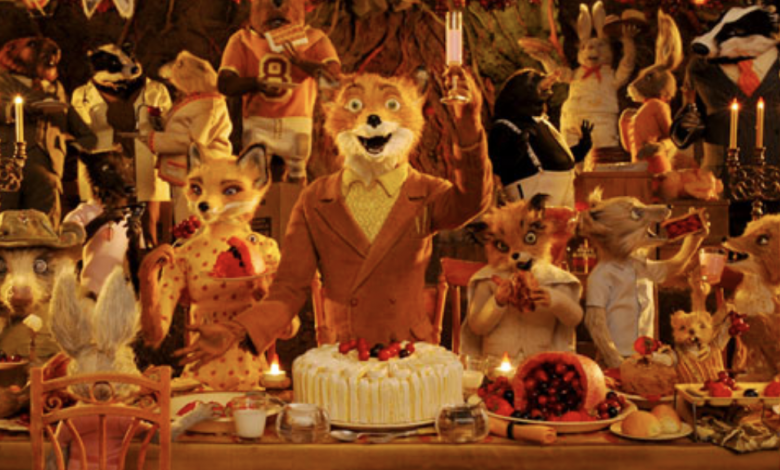
Hannah Hughes ‘25 / Emertainment Monthly Staff Writer
Introduction
Food is essential to survival. According to Britannica, food is a “substance consisting essentially of protein, carbohydrate, fat, and other nutrients used in the body of an organism to sustain growth and vital processes and to furnish energy.”
But beyond its basic definition, food is so much more. Everytime we eat, we are further confirming that food is a very big part of our societal and personal rituals and traditions, in more ways than we might think.
We see food across our media today in everything from film, to television shows, to advertising. Popular websites like PureWow and Time Out make lists about the best food scenes in movies, but what makes it so tantalizing to see our favorite meals on the silver screen?
From the beginning of our lives, food is integrated as an important part of time with those we love. From family dinners and first dates, to crying alone on the couch with a tub of ice cream, we use food to express ourselves.
Food is a tangible extension of what we are feeling inside, and this is why scenes with food in movies are extremely effective. They allow the audience to understand the character’s motives and emotions in a way that’s relatable and easily digestible (no pun intended).
Celebration
Most commonly in the media, we see food as a means of celebration. Large spreads of every food imaginable, laid out for the characters to pile onto their plates and feast to their heart’s content. As a viewer, seeing this portrayed is extremely satisfying, because it means something has been accomplished.
In Wes Anderson’s Fantastic Mr. Fox, we are celebrating the success of Mr. Fox’s (George Clooney) heist. Finally, it seems as if our troubles are over, and we can be happy that our character’s can finally sit down and enjoy a meal all together.

In the first installment of the Harry Potter series, the feast appears as a way to celebrate the beginning of a new school year. Harry (Daniel Radcliffe), initially very nervous after being thrown into this new world of wizards and witches, melts into comfort after being presented with large plates of British delicacies. The audience breathes a huge sigh of relief, as they watch the students laugh, talk, and most importantly, eat.
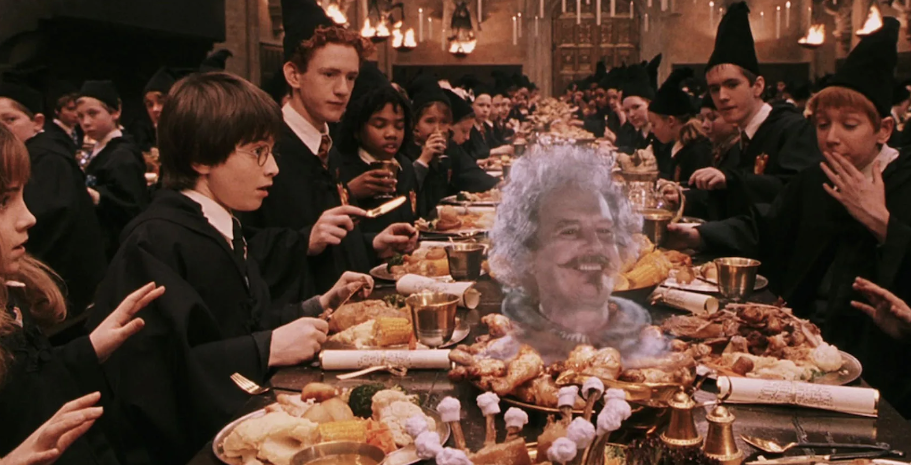
A really important aspect of these scenes, and meals of celebration as a whole, is community. Because, what is a celebration if you have no one to share it with?
According to a 2017 study done by the University of Oxford, “the more often people eat with others, the more likely they are to feel happy and satisfied with their lives.” According to the survey given, 76% of participants thought that sharing a meal was a good way to bring people together.
From birthdays, to holidays, to special occasions, almost everyone has experienced a celebratory meal in their life. They are high-spirited and high energy, and most often leave you feeling fulfilled in a way you can’t quite describe. These grand meals are as much about the conversation and time spent together as they are about the food. They really function as a social gathering and way to connect with others, and serve to honor someone or something extraordinary.
Through these scenes in film, we as an audience can feel the warmth and comfort associated with a character’s bountiful feast, and can’t help but smile along with them as we imagine ourselves enjoying such a meal, surrounded by the ones we love.
Comfort
Going hand and hand with celebration is of course, comfort. Food can offer us reassurance in hard times beyond any words said or gestures done.
In times of great trouble or loss, you will be greeted with casseroles, mac and cheese, and sometimes entire meals from your friends, family, neighbors, and people around you. When people want to show they care but don’t know how, they will usually turn to food to help.
Doctor Marilyn A. Mendoza, a psychologist based in New Orleans, explains in her article for Psychology Today how food is essential to grieving, saying that “mourners believed their food offerings were helpful to the soul’s travels to the afterlife as well as a way of honoring and remembering their loved one. While feeding the dead has not been found in all parts of the world, bringing food to those in mourning is a universal custom”.
In a similar way, food offers a safe and comfortable escape for some of our favorite characters in movies. Disney & Pixar are quite famous for this, using eating and preparing good food as a way to show our characters gaining traction and “warming up” to the unfortunate situation they may find themselves in.
For example, after Belle (Paige O’Hara) has traded her freedom for her father’s in Disney’s Beauty and the Beast, she is extremely homesick. In order to cheer her up, Lumiere arranges a fabulous meal for her, putting a smile on her face.
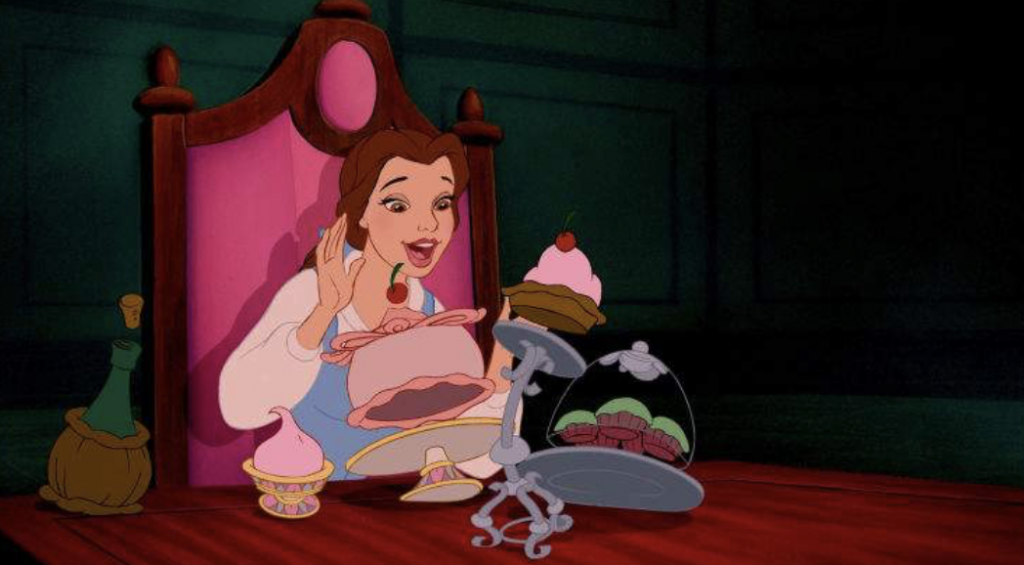
In 2007’s Ratatouille, after being separated from the rest of his family after a harrowing escape, Remy the rat (Patton Oswalt) finds himself alone in Paris. He makes his way into a French fine dining restaurant, where he spices up a delicious pot of soup, dancing and tossing ingredients in as if he hasn’t got a care in the world.

In one of their most recent animated films, Disney’s Encanto features Julieta Madrigal (Angie Cepeda), who is able to heal people with the food she makes, namely her arepas con queso (a cheese stuffed cornmeal cake).
As our heroine Mirabel (Stephanie Beatriz) struggles throughout the film, she finds comfort in her mother, as well as the food she makes.
Although it’s clear that Julieta’s food is able to help people in a more literal and physical sense, the concept draws on the well known theory that food is healing for the soul itself.
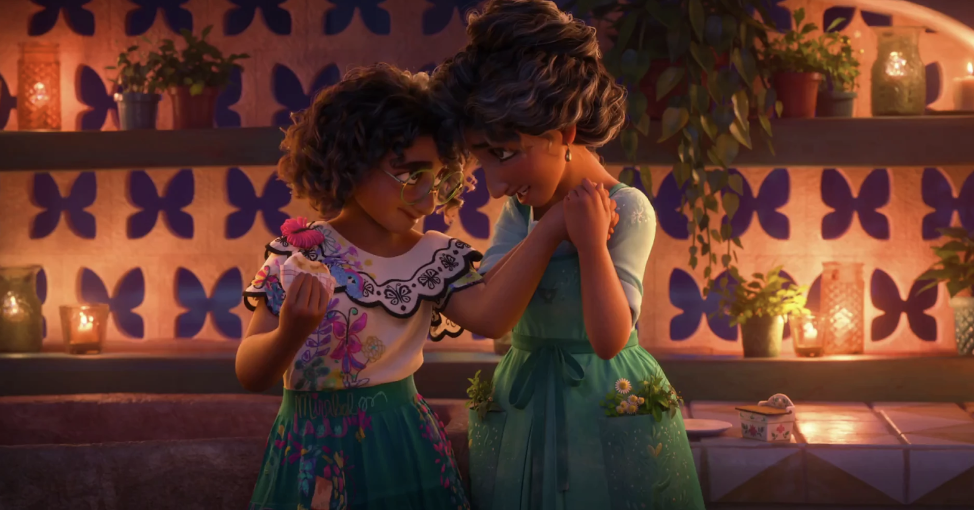
Pleasure & Temptation
In life, food is the subject of great temptation for many people. Nothing is quite as satisfying as filling an empty stomach with the food you’ve been craving. In film, food is often used as bait, or a bargaining chip, and can be allegorical for a character’s deepest desires.
A prime example of this is Henry Selick’s Coraline. When our protagonist Coraline (Dakota Fanning) enters the “Other World”, she’s presented with the dinner of her dreams. Coraline’s Other Parents dote on her, her Other Mother explaining that the meal contains all of her favorites. The meal is so fanciful it even includes a moving gravy boat train.
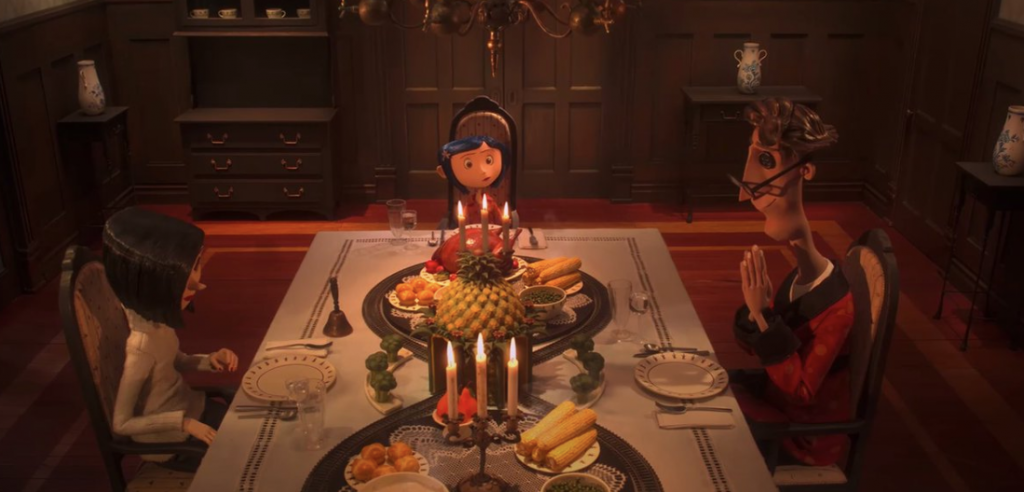
This meal is much grander than Coraline’s casserole dinner in the real world which is served with a side of uncomfortable family dialogue and fighting.

Of course, given the choice between the two, anyone would pick the Other Mother’s feast, but there is a deeper desire that lies beyond the obvious indulgence.
Coraline struggles throughout the film with her family dynamic in the real world. She’s often at odds with her Mother, Mel (Teri Hatcher) and feels as if she doesn’t get enough attention from her Father, Charlie (John Hodgman). The Other Mother’s meal is a sign of devotion and love, something that Coraline feels she’s lacking. All Coraline has ever wanted is her parents in the real world to pay attention to her and her interests, and in the Other World, even the small gesture of a well-cooked meal signifies that to her.
The dinner is just one of many ways the Other Mother lures Coraline in and creates a false sense of security in the Other World. In this case, food is used as a vessel for manipulation, as it is something that can reach Coraline on a deeper level of longing and desire.
Similarly, in Pirates of the Caribbean: The Curse of the Black Pearl, Hector Barbossa (Geoffrey Rush) invites Elizabeth Swann (Kiera Knightly) to a lavish feast in his Captain’s Quarters. It turns out that the meal serves as a way for the audience to understand the curse that has befallen Barbossa and his crew.
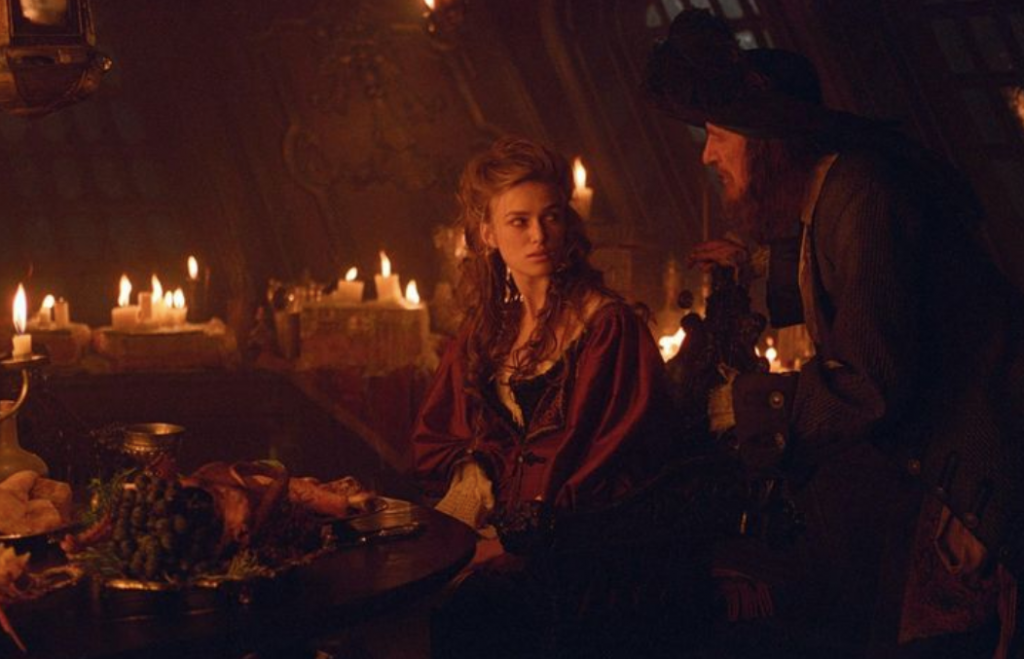
A living skeleton crew, the pirates aboard the Black Pearl are unable to experience life’s simple pleasures, eating and drinking being one of these. This anguish has driven the pirates absolutely mad, as they lead meaningless and endless lives because of it.
The film is very clever, as moments before we hear Barbossa’s tales of woe, we see Elizabeth scarf down some food and wine. The Captain simply watches her, seemingly reminiscing about a time when he too could enjoy a such a meal.
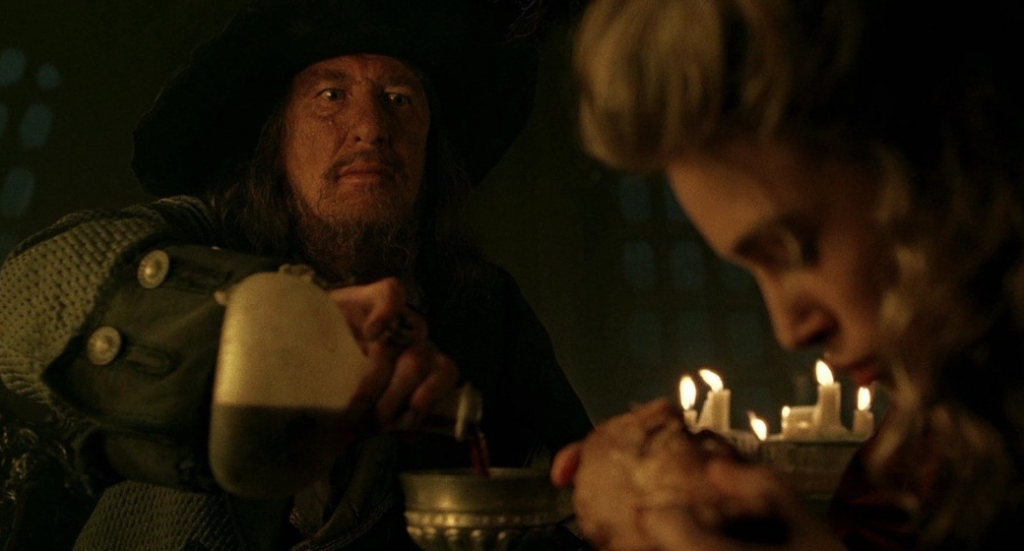
This sort of imagery also adds a layer to Barbossa’s character, as it helps the viewers to sympathize with him, even though he is the film’s primary antagonist. Could you imagine being eternally hungry? Or thirsty? When you think of the existence that way, it puts the pirates’ actions into perspective, and makes them more than just one-dimensional villains by, once again, shedding light on their inner desires.
Perhaps the most famous example of pleasure and food is Willy Wonka & The Chocolate Factory. A 1971 film based on the children’s book by Roald Dahl, similarly named Charlie & The Chocolate factory. When the five children enter Willy Wonka’s factory, they are greeted by the eccentric candymaker himself. Wonka (Gene Wilder) leads them to a glorious paradise made entirely of candy.
The room, aptly named “the chocolate room”, features large candy mushrooms and melons, grass, as well as a chocolate river. Everything is edible, and the children and adults alike waste no time exploring and eating all the candy they can fit in their mouths. Of course, all the rooms in Wonka’s factory are fantastical in nature, but there is a point to this being the first room that his guests see.

Wonka sets the bar high with the chocolate room, establishing nothing is off limits during their time with him. Of course, we learn that he is trying to find someone to take his place and run the factory, so giving the children the opportunity to run free in a place full of delicious temptation would give him an opportunity to examine their behavior, and their interactions with the landscape actually say a lot about their personality!
At one point, we watch Veruca Salt (Julie Dawn Cole) impatiently bash a large candy melon on a rock to get the jelly that’s inside. This shows her need to get what she wants, as well as her impatience. Both potentially unsavory traits where Wonka is concerned.

Again, Wonka uses the chocolate room to his benefit, using the sheer magnitude and temptation to instantly gain control over his guests.
Romance
Looking at the pleasure associated with food on a deeper level, we reach romance. Surely, this is what comes to mind for most people when they think of food in film. A fancy dinner date, a luscious picnic on a sunny day, an intimate meal shared between two lovers, all of these are excellent examples of how food and romance go hand in hand.
Firstly, for a lot of people, sharing food has an element of vulnerability to it. Exposing what you like to eat and how you like to eat it can be something very important to a person (although they may not realize it outright).
According to the Huffington Post, we tend to turn to food to woo our partner, which is actually quite valid from a scientific standpoint. In the article, associate professor of Psychology Maryanna Fisher explains that “food is a way to display skills to a potential mate”. Hence the reason you may take your partner out to a fancy steakhouse instead of a McDonalds on the first date.
Cooking and taking the time to prepare food is also what Fisher calls “an inconvenience display” meaning that we can show another person that we care by taking the time to do something to benefit them. Doing this for someone shows our true care and compassion on a basic psychological level. Hence the reason you may take your partner out for that special dinner, or cook them their favorite food. It’s a genuine way to show your love for them.
In film, the quintessential example of this is Disney’s 1955 film, Lady & The Tramp. In this famous scene, Tramp (Larry Roberts), a stray dog who lives on the street, shows Lady (Barbara Luddy), a spoiled cocker-spaniel, around the town. They have a spaghetti dinner at Tony’s Restaurant, where they share some linguine and a kiss. At the end of their meal, Tramp even offers the shy Lady the last meatball as a token of affection.
Taking Lady to dinner exemplifies Tramp showing her he cares for her, as he treats her to a very special meal for just the two of them, and has gone out of his way to take her around the city and eat with her.
Another more recent example of this is the 2022 Horror film Fresh. Beginning with a quite unsavory dinner date, our protagonist Noa (Daisy Edgar-Jones) struggles to continue dating after a streak of bad luck. Until she meets Steve (Sebastian Stan), a seemingly mild-mannered nice guy, and their relationship flourishes. Much of their relationship is centered around food. They meet in a grocery store and often chat over dinner and snacks.
However, Noa is quickly plunged into a nightmare as she learns her newfound boyfriend is actually a cannibal, selling the meat of his victims to high-end clients. And she’s next on the list. However, his passion for cooking is still present. Steve uses food as a tool to get close to his victims, which also exemplifies how sharing food with someone you care about has that certain element of vulnerability to it, and people around you can take advantage of that.
Even after showing Noa his true colors, he still tries to impress her by cooking her a meal of his design. He is careful in the kitchen, like a professional chef, taking his time and dancing around the room in the process, obviously overjoyed to be sharing his passion with someone . When you cook a meal, it almost feels like an extension of yourself, and Steve trying to introduce Noa to his cannibalistic lifestyle is an example of giving yourself away through food (albeit a disgusting one).

Fresh does an excellent job at taking the audience’s typical expectations when it comes to food and romance and flipping them on our head, using that relationship we all are familiar with to create true horror and discomfort.
Disgust
The pleasurable experience of food toes a fine line, as an excess of one’s favorite dishes can instantly turn to gluttony if pushed far enough. Since we’ve already established how food imagery is close to our hearts (and our stomachs), what happens when we subvert that and present food as a punishment?
Like many of our feelings about food, the notion of gluttony and the concept’s place in our society has been around for centuries, as it is part of the Catholic Church’s’ ‘seven deadly sins”, which are practices that lead one astray from god. According to History.com, the idea of listing one’s vices began all the way back in the 4th Century. The seven deadly sins began as “eight evil thoughts”, recorded by Christian monk Evagrius Ponticus. Through a student of Ponticus, these ideas were brought to the Western Church where they were eventually translated and rearranged into the Catholic church’s set of seven. In addition to eating in excess, early christian theologians believed that gluttony included drinking alcohol and even considered thinking about enjoying too much good food to be sinful.
Despite their religious context, the seven deadly sins have been featured heavily in pop culture. With Catholicism’s practices, figures, and concepts deeply rooted in our society, excessive eating has always been frowned upon, and that is partly the reason why we feel such visceral disgust when we see characters in media do just that.
No other movie really can compare to 2009’s Matilda when it comes to a food scene that defines disgust. In the film, the mean and cruel Miss Trunchbull (Pam Ferris) punishes one of her students for stealing a piece of her dessert. Bruce Bogtrotter (Jimmy Karz), the student in question, is sat down in front of the whole school and given a comically large chocolate cake, which is forced to finish before anyone can go home.
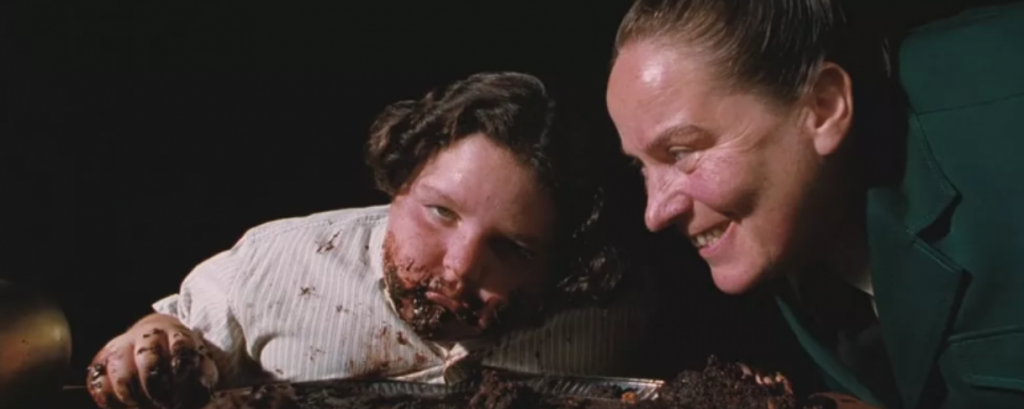
Bruce struggles to get through the ginormous cake, picking up fistfuls with his hands and shoveling them in his mouth, smearing chocolate everywhere. However, with a little encouragement from his classmates, Bruce is able to finish the large confection and everyone can go home for the day.
So why do we feel a little queasy watching Bruce? Well, we know how eating too much food makes us feel. Few people haven’t experienced eating one too many bites of delicious food and feeling sick afterwards. When we see characters experiencing this discomfort, it’s not hard to imagine what they must be feeling, which elicits a reaction!
Buddy (Will Ferrell) shows off his weird eating habits in 2003’s holiday classic Elf, where he explains elf culture and their relation to food, and how that differs from a human. To drive the point home, we watch Buddy eat spaghetti topped with copious amounts of candy and maple syrup.

Although this is a point of humor in the movie, watching Buddy eat this sweetened spaghetti really drives home to the audience how Buddy’s world differs from ours, and how he truly is a fish out of water in New York City, and in the human world as a whole. Though we may feel a little gross watching Buddy shovel maple-syrup soaked pasta in his mouth, it’s almost endearing when we see how much he’s enjoying it.
Conclusion
Across all media, food is essentially a tangible extension of emotion. Through eating, it’s easy for the audience to relate to them and imagine what they’re feeling, which creates a connection between viewer and character. This established connection is grounds for a deeper understanding between the audience and the media they are consuming.
So next time you see a character eating your favorite meal, think about what that food says about them, and extensively, what that might say about you!
outstanding and interesting article!